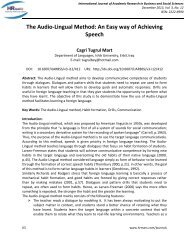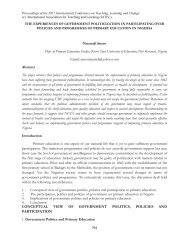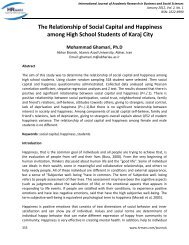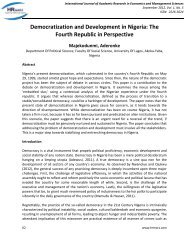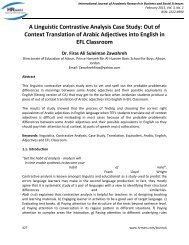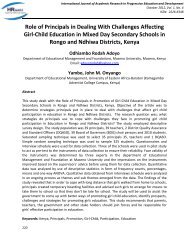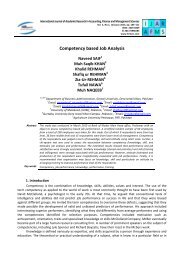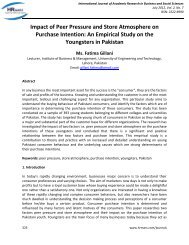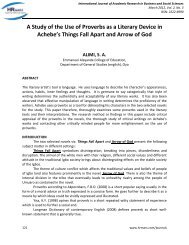A Study on the Retirement Planning Behaviour of Working - Human ...
A Study on the Retirement Planning Behaviour of Working - Human ...
A Study on the Retirement Planning Behaviour of Working - Human ...
Create successful ePaper yourself
Turn your PDF publications into a flip-book with our unique Google optimized e-Paper software.
Internati<strong>on</strong>al Journal <strong>of</strong> Academic Research in Ec<strong>on</strong>omics and Management Sciences<br />
April 2012, Vol. 1, No. 2<br />
ISSN: 2226-3624<br />
A <str<strong>on</strong>g>Study</str<strong>on</strong>g> <strong>on</strong> <strong>the</strong> <strong>Retirement</strong> <strong>Planning</strong> <strong>Behaviour</strong> <strong>of</strong><br />
<strong>Working</strong> Individuals in Malaysia<br />
M.Krishna Moorthy<br />
Thamil Durai a/l Chelliah<br />
Chiau Shu Sien<br />
Lai Chin Le<strong>on</strong>g<br />
Ng Ze Kai<br />
W<strong>on</strong>g Choy Rhu<br />
W<strong>on</strong>g Yoke Teng<br />
Universiti Tunku Abdul Rahman,<br />
Malaysia<br />
krishnam@utar.edu.my<br />
ABSTRACT This cross-secti<strong>on</strong>al study is an explanatory research intended to establish <strong>the</strong><br />
relati<strong>on</strong>ship between <strong>the</strong> retirement planning behavior and <strong>the</strong> various<br />
factors affecting <strong>the</strong> retirement planning behavior. A total <strong>of</strong> 300 working<br />
individuals in <strong>the</strong> age group <strong>of</strong> 26 to 55 years had participated in this study.<br />
The objectives <strong>of</strong> this study are to examine <strong>the</strong> retirement planning behavior<br />
<strong>of</strong> working individuals. This study c<strong>on</strong>tributes a clear view through <strong>the</strong><br />
symbolic interacti<strong>on</strong> <strong>the</strong>ory and several past relevant empirical studies. The<br />
results identified several significant variables in <strong>the</strong> predicti<strong>on</strong> <strong>of</strong> working<br />
individuals’ retirement planning behavior, including age, educati<strong>on</strong> level and<br />
income level. The findings <strong>of</strong> this research support <strong>the</strong> research model in<br />
which potential c<strong>on</strong>flict in retirement planning, attitude toward retirement<br />
and retirement goal clarity are <strong>the</strong> significant predictors <strong>of</strong> retirement<br />
planning behavior. The results <strong>of</strong> this study have implicati<strong>on</strong>s for working<br />
individuals to do early planning for retirement to enable <strong>the</strong>m to have a<br />
str<strong>on</strong>g financial base after retirement<br />
KEY WORDS <strong>Retirement</strong> planning, post-employment planning, old-age planning, savings<br />
for retirement<br />
54 www.hrmars.com
JEL CODES<br />
Internati<strong>on</strong>al Journal <strong>of</strong> Academic Research in Ec<strong>on</strong>omics and Management Sciences<br />
April 2012, Vol. 1, No. 2<br />
ISSN: 2226-3624<br />
C12, C43, H75.<br />
Introducti<strong>on</strong><br />
The Statistics <strong>of</strong> Labour Force, Malaysia, January 2010- series 7/ March 2010<br />
dem<strong>on</strong>strated that <strong>the</strong> number <strong>of</strong> employed pers<strong>on</strong> increased by 3.4 percent in January 2010 to<br />
11.1875 milli<strong>on</strong> as compared with 10.817 milli<strong>on</strong> in January 2009. As this situati<strong>on</strong> c<strong>on</strong>tinues,<br />
<strong>the</strong> number <strong>of</strong> pre-retirees will increase in <strong>the</strong> future. The reality hits when people find that<br />
<strong>the</strong>y are not affordable to retire because <strong>the</strong>y had not seriously put aside <strong>the</strong> m<strong>on</strong>ey in <strong>the</strong>ir<br />
early life (Habib, 2007). Individuals are encouraged to start planning for <strong>the</strong>ir later life <strong>of</strong> <strong>the</strong>ir<br />
retirement especially during <strong>the</strong>ir golden years and not <strong>on</strong>ly nearing <strong>the</strong> retirement. Therefore,<br />
retirement planning becomes an essential issue <strong>of</strong> <strong>the</strong> employee’s life. Malaysians have less<br />
c<strong>on</strong>fidence about preparing retirement plan due to <strong>the</strong> financial illiteracy (Hunt, 2009).<br />
According to Life Insurance Associati<strong>on</strong> <strong>of</strong> Malaysia (LIAM), <strong>on</strong>ly less than 5% <strong>of</strong> Malaysians are<br />
ready for retirement (Habib, 2007).<br />
Problem Statement<br />
The pre-retirees and workers are woefully unprepared for <strong>the</strong>ir golden retirement years.<br />
Bernheim (1992) found that <strong>the</strong>y save just <strong>on</strong>e-third <strong>of</strong> what <strong>the</strong>y needed to retire comfortably.<br />
In fact, Warshawsky and Ameriks (2000) indicated that half <strong>of</strong> <strong>the</strong> individuals aging between 25-<br />
71 years will not have sufficient savings to support <strong>the</strong>mselves in retirement. In many<br />
developing countries, <strong>the</strong> retirement has not been completely instituti<strong>on</strong>alized (Szinovacz,<br />
2003).<br />
Many households are unfamiliar even about <strong>the</strong> most basic ec<strong>on</strong>omic c<strong>on</strong>cepts needed<br />
to make saving and investment decisi<strong>on</strong>s (Lusardi & Mitchell, 2007). The young and older<br />
citizens in Malaysia appeared to be woefully under-informed about basic financial literacy;<br />
c<strong>on</strong>cepts, with serious implicati<strong>on</strong>s for saving, retirement planning, mortgages, and o<strong>the</strong>r<br />
decisi<strong>on</strong>s. Due to financial illiteracy, <strong>the</strong> result is that no proper saving planning for <strong>the</strong>ir<br />
afterlife <strong>of</strong> retirement.<br />
The younger generati<strong>on</strong> <strong>of</strong> working individuals today think that retirement planning is a<br />
burden for <strong>the</strong>m because it involves l<strong>on</strong>g-term planning. According to LIAM those people in 20’s<br />
think that <strong>the</strong>y are too young to think about retirement, while in 30’s and 40’s tend to believe<br />
<strong>the</strong>y are prepared because <strong>the</strong>y have <strong>the</strong>ir Employee Provident Fund (EPF) savings. Meanwhile<br />
<strong>the</strong> reality at 55 is that most people cannot afford to retire, since <strong>the</strong>y prepared late for<br />
retirement (Habib, 2007).<br />
55 www.hrmars.com
Internati<strong>on</strong>al Journal <strong>of</strong> Academic Research in Ec<strong>on</strong>omics and Management Sciences<br />
April 2012, Vol. 1, No. 2<br />
ISSN: 2226-3624<br />
Hershey (2004) argued that although demographic factors have influenced <strong>the</strong><br />
retirement saving decisi<strong>on</strong>s, in c<strong>on</strong>trast, psychological factors also have direct effect <strong>on</strong> savings<br />
decisi<strong>on</strong>s (Hira, Rock and Loibl, 2009) .<br />
Research Questi<strong>on</strong>s and Objectives<br />
In this study, two research questi<strong>on</strong>s are addressed: (1) Is <strong>the</strong> retirement planning<br />
behaviour <strong>of</strong> working individuals affected by different age groups? (2) What are <strong>the</strong> factors<br />
influencing retirement planning behaviour? The objectives <strong>of</strong> this study are: (1) To examine <strong>the</strong><br />
retirement planning behaviour <strong>of</strong> working individuals from different age groups. (2) To examine<br />
whe<strong>the</strong>r o<strong>the</strong>r demographic variables are relatively important for retirement planning. (3) To<br />
determine <strong>the</strong> role <strong>of</strong> psychological variables in retirement planning behaviour. (4) To<br />
determine <strong>the</strong> characteristics <strong>of</strong> <strong>the</strong> demographic variables.<br />
Significance <strong>of</strong> <strong>the</strong> <str<strong>on</strong>g>Study</str<strong>on</strong>g><br />
This study benefits <strong>the</strong> society especially working individuals to realize <strong>the</strong> importance<br />
<strong>of</strong> <strong>the</strong> retirement in life and <strong>the</strong> factors that might affect <strong>the</strong>ir behaviour <strong>of</strong> <strong>the</strong> retirement<br />
planning. Time might play an important role in <strong>the</strong> success <strong>of</strong> <strong>the</strong> retirement planning,<br />
<strong>the</strong>refore, readers might find out when is <strong>the</strong> suitable time to start <strong>the</strong> planning from this<br />
study. The government could refer this study to know <strong>the</strong> current situati<strong>on</strong> in order to support<br />
<strong>the</strong> citizens in developing a better envir<strong>on</strong>ment in <strong>the</strong>ir afterlife <strong>of</strong> retirement.<br />
Review <strong>of</strong> <strong>the</strong> Literature<br />
According to Kim, Kw<strong>on</strong> and Anders<strong>on</strong> (2004), <strong>the</strong> individuals’ retirement c<strong>on</strong>fidence<br />
tend to be higher than o<strong>the</strong>rs as <strong>the</strong>y calculated <strong>the</strong>ir retirement fund needs and had more<br />
savings. The level <strong>of</strong> c<strong>on</strong>fidence will increase as <strong>the</strong> higher household income provided that<br />
<strong>the</strong>y are with better health. The working individuals who received workplace financial<br />
educati<strong>on</strong> and advice earlier help <strong>the</strong>m to have more c<strong>on</strong>fidence toward retirement planning<br />
(Power & Hira, 2004).<br />
According to W<strong>on</strong>g and Earl (2009), retirees neglected retirement planning because <strong>the</strong>y<br />
have certain level <strong>of</strong> difficulty in adjusting to retirement. In <strong>the</strong> findings, <strong>the</strong> result suggests that<br />
<strong>on</strong>ly individuals: (1) demographic; and (2) health, and organizati<strong>on</strong>al: (1) c<strong>on</strong>diti<strong>on</strong>s <strong>of</strong><br />
workforce exit influences predict a better retirement planning. Psychosocial: (1) work centrality<br />
influences have no significant impact <strong>on</strong> retirement planning behaviour in an integrated model.<br />
Lusardi and Mitchell (2007) showed that planners accumulate large wealth than n<strong>on</strong>planners<br />
through saving, investment, probability <strong>of</strong> selling house to finance retirement and<br />
56 www.hrmars.com
Internati<strong>on</strong>al Journal <strong>of</strong> Academic Research in Ec<strong>on</strong>omics and Management Sciences<br />
April 2012, Vol. 1, No. 2<br />
ISSN: 2226-3624<br />
o<strong>the</strong>rs. Joo and Pauwels (2002) indicated that for those who are younger and have higher level<br />
<strong>of</strong> educati<strong>on</strong> reported a higher retirement c<strong>on</strong>fidence. Hence <strong>the</strong> younger generati<strong>on</strong> have an<br />
early retirement planning.<br />
Lai, Lai and Lau (2009) found that <strong>the</strong>re is significant difference between teaching<br />
positi<strong>on</strong>, educati<strong>on</strong> and age across <strong>the</strong> annual income levels from academics’ perspective. This<br />
survey found that academics exhibited positive attitude toward m<strong>on</strong>ey and income c<strong>on</strong>sidered<br />
to be <strong>the</strong> prime motivator.<br />
According to Elder & Rudolph (1999) planning activities imply a higher likelihood <strong>of</strong><br />
satisfacti<strong>on</strong> even for those whose retirement decisi<strong>on</strong>s were not made voluntarily (ei<strong>the</strong>r<br />
through health problems or an employer mandate). Marital status, health status, level <strong>of</strong><br />
educati<strong>on</strong>, whe<strong>the</strong>r <strong>the</strong> individual was forced to retire, and pre-retirement occupati<strong>on</strong> as well<br />
as <strong>the</strong> retirement planning have an impact <strong>on</strong> <strong>the</strong> level <strong>of</strong> <strong>the</strong> retirement satisfacti<strong>on</strong>.<br />
The future time perspective, financial knowledge, and financial risk tolerance are<br />
important variables when it comes to understanding individuals’ retirement saving practices<br />
(Jacobs-Laws<strong>on</strong> & Hershey, 2005). Stawski, Hershey and Jacobs-Laws<strong>on</strong> (2007) indicated that<br />
retirement goal clarity is a significant predictor <strong>of</strong> planning practices, and planning, in turn to<br />
predict savings tendencies. This study found that income and age were important elements <strong>of</strong><br />
<strong>the</strong> model with income accounting for roughly half <strong>of</strong> <strong>the</strong> explained variance in savings<br />
c<strong>on</strong>tributi<strong>on</strong>s.<br />
Dvorak and Hanley (2010) found that participants have a fairly good understanding <strong>of</strong><br />
<strong>the</strong> basic mechanics <strong>of</strong> <strong>the</strong> plan but <strong>the</strong>y have insufficient knowledge to differentiate am<strong>on</strong>g<br />
numerous investment opti<strong>on</strong>s. Women have low knowledge, income and educati<strong>on</strong> compared<br />
with men. This study pointed that <strong>the</strong> older participants are more likely to make pers<strong>on</strong>al<br />
c<strong>on</strong>tributi<strong>on</strong>s. However, educati<strong>on</strong> is perhaps <strong>the</strong> most significant determinant <strong>of</strong> financial<br />
literacy.<br />
Review <strong>of</strong> Relevant Theory<br />
Symbolic interacti<strong>on</strong> <strong>the</strong>ory is a social science <strong>the</strong>ory and was applied in this study. This<br />
<strong>the</strong>ory claims that facts are based <strong>on</strong> and directed by symbols (Aksan, Kisac, Aydin &<br />
Demirbuken, 2009). According to this <strong>the</strong>ory, people live both in <strong>the</strong> natural and <strong>the</strong> symbolic<br />
envir<strong>on</strong>ment and focuses attenti<strong>on</strong> <strong>on</strong> <strong>the</strong> way that people interact through symbols such as<br />
words, gestures, rules and roles. There are three core principles in symbolic interacti<strong>on</strong><br />
perspective <strong>of</strong> Blumer, <strong>the</strong> founder <strong>of</strong> symbolic interacti<strong>on</strong> <strong>the</strong>ory, which are meaning,<br />
language and thinking. There are five c<strong>on</strong>cepts in symbolic interacti<strong>on</strong> <strong>the</strong>ory namely; role, self,<br />
57 www.hrmars.com
Internati<strong>on</strong>al Journal <strong>of</strong> Academic Research in Ec<strong>on</strong>omics and Management Sciences<br />
April 2012, Vol. 1, No. 2<br />
ISSN: 2226-3624<br />
interacti<strong>on</strong>, culture and norm (Meltzer, Petras & Reynolds, 1975). The working individuals are<br />
<strong>the</strong> target samples in this study. The symbolic interacti<strong>on</strong> <strong>the</strong>ory, helped in finding <strong>the</strong><br />
perspective <strong>of</strong> working individuals toward <strong>the</strong> proximity <strong>of</strong> retirement planning. As <strong>the</strong> working<br />
individuals are divided into three groups according to <strong>the</strong>ir age, <strong>the</strong>y might have different<br />
thinking and perspective toward <strong>the</strong> retirement planning am<strong>on</strong>g <strong>the</strong>m. As a result, <strong>the</strong> attitude<br />
<strong>of</strong> individuals will influence <strong>the</strong>ir behaviour <strong>on</strong> making decisi<strong>on</strong> in retirement planning.<br />
Moreover, <strong>the</strong> way <strong>of</strong> <strong>the</strong>ir thinking might influence <strong>the</strong> group am<strong>on</strong>g <strong>the</strong>m due to <strong>the</strong> social<br />
interacti<strong>on</strong> process. The working individuals who are more knowledgeable about <strong>the</strong><br />
retirement planning tend to influence o<strong>the</strong>r individuals from his or her point <strong>of</strong> view. When <strong>the</strong><br />
interacti<strong>on</strong> am<strong>on</strong>g <strong>the</strong> individuals is successful, <strong>the</strong> retirement planning might become a culture<br />
<strong>of</strong> society.<br />
Figure 1: C<strong>on</strong>ceptual Framework<br />
Age Group<br />
Educati<strong>on</strong> level<br />
Income level<br />
Goal Clarity<br />
Potential c<strong>on</strong>flict in<br />
retirement<br />
planning<br />
Attitude toward<br />
retirement<br />
<strong>Retirement</strong> <strong>Planning</strong><br />
<strong>Behaviour</strong><br />
Adapted from: (1) Hira, Rock and Loibl (2009); (2) Lai, Lai and Lau (2009) and (3) Stawski,<br />
Hershey and Jacobs-Laws<strong>on</strong> (2007).<br />
Hypo<strong>the</strong>ses Development<br />
Based <strong>on</strong> <strong>the</strong> literature review, <strong>the</strong> following hypo<strong>the</strong>ses have been developed.<br />
H1 Age group is significant related to retirement planning behaviour.<br />
H2 Income level is significant related to retirement planning behaviour.<br />
H3 Educati<strong>on</strong> level is significant related to retirement planning behaviour.<br />
H4 Goal clarity is significant related to retirement planning behaviour.<br />
H5 Attitude toward retirement is significant related to retirement planning<br />
behaviour.<br />
58 www.hrmars.com
Internati<strong>on</strong>al Journal <strong>of</strong> Academic Research in Ec<strong>on</strong>omics and Management Sciences<br />
April 2012, Vol. 1, No. 2<br />
ISSN: 2226-3624<br />
H6 Potential c<strong>on</strong>flict in retirement is significant related to retirement planning<br />
behaviour.<br />
Research Design<br />
This study is emphasized <strong>on</strong> studying why most people cannot afford to retire at 55<br />
(Habib, 2007) in order to explain <strong>the</strong> relati<strong>on</strong>ship between <strong>the</strong> factors with <strong>the</strong> retirement<br />
planning. This study used survey strategy that collects quantitative data which is through <strong>the</strong><br />
questi<strong>on</strong>naire. The data collected were used to explain <strong>the</strong> relati<strong>on</strong>ship between <strong>the</strong> factors<br />
and retirement planning.<br />
Populati<strong>on</strong> Sample and Sampling Procedures<br />
A total <strong>of</strong> 300 working individuals have participated in this study. Sample <strong>of</strong> this study is<br />
limited to working individuals from 26 to 55 years. Due to <strong>the</strong> equal chances <strong>of</strong> each working<br />
individual from 26 to 55 years being selected am<strong>on</strong>g <strong>the</strong> populati<strong>on</strong> in Malaysia is unknown,<br />
<strong>the</strong> sampling technique used is n<strong>on</strong>-probability sampling. Quota sampling is used to select <strong>the</strong><br />
data from a large populati<strong>on</strong> <strong>of</strong> working individuals. In this study, working individuals are<br />
divided into 3 age groups, which are 26 to 35, 36 to 45 and 46 to 55 years old and each group’s<br />
sample size is 100. The selected areas <strong>of</strong> this study in Malaysia are Kuala Lumpur, Selangor,<br />
Ipoh and Johor.<br />
Data Collecti<strong>on</strong> Method<br />
This study is c<strong>on</strong>ducted by collecting <strong>the</strong> primary data from <strong>the</strong> samples to represent<br />
<strong>the</strong> populati<strong>on</strong>. The method used in collecting data is <strong>the</strong> questi<strong>on</strong>naire technique. Each<br />
participant is asked to resp<strong>on</strong>d to <strong>the</strong> same set <strong>of</strong> questi<strong>on</strong>s, as it provides an efficient way in<br />
collecting resp<strong>on</strong>ses from a large sample <strong>of</strong> working individuals to do quantitative analysis.<br />
Pilot Survey<br />
A pilot survey <strong>on</strong> 30 resp<strong>on</strong>dents was c<strong>on</strong>ducted in June 2010. In this pilot survey, <strong>the</strong><br />
value <strong>of</strong> Cr<strong>on</strong>brach’s alpha <strong>of</strong> all <strong>the</strong> independent variables and dependent variable were less<br />
than 0.6 and c<strong>on</strong>sidered poor in reliability test. This indicates that <strong>the</strong> internal c<strong>on</strong>sistency<br />
reliability <strong>of</strong> <strong>the</strong> measures in this pilot survey is c<strong>on</strong>sidered to be poor. After ensuring <strong>the</strong><br />
reliabilities obtained is correct, <strong>the</strong> adjustment <strong>of</strong> changing <strong>the</strong> wording <strong>of</strong> <strong>the</strong> questi<strong>on</strong>naire is<br />
started immediately. After changes in <strong>the</strong> questi<strong>on</strong>naire, <strong>the</strong> resp<strong>on</strong>dents found that <strong>the</strong><br />
questi<strong>on</strong>s are easier to understand and able to choose <strong>the</strong> most appropriate answer. Thus, <strong>the</strong><br />
internal c<strong>on</strong>sistency reliability <strong>of</strong> <strong>the</strong> measures used in independent variables and dependent<br />
variable <strong>of</strong> this study can be c<strong>on</strong>sidered acceptable. In sec<strong>on</strong>d pilot survey, all <strong>the</strong> reliabilities<br />
above <strong>the</strong> 0.7 in range and are c<strong>on</strong>sidered acceptable. Attitude toward retirement and<br />
potential c<strong>on</strong>flict scored <strong>the</strong> Cr<strong>on</strong>bach’s alpha more than 0.8, it can be c<strong>on</strong>sidered good.<br />
59 www.hrmars.com
Internati<strong>on</strong>al Journal <strong>of</strong> Academic Research in Ec<strong>on</strong>omics and Management Sciences<br />
April 2012, Vol. 1, No. 2<br />
ISSN: 2226-3624<br />
Variables and Measurement<br />
In this study, <strong>the</strong>re are six independent variables and <strong>on</strong>e dependent variable. The<br />
independent variables are divided into two secti<strong>on</strong>s, which are demographic variables: (1) age;<br />
(2) educati<strong>on</strong> level; and (3) income level and psychology variables: (1) goal clarity; (2) attitude<br />
toward retirement; and (3) potential c<strong>on</strong>flicts in retirement planning. The dependent variable is<br />
retirement planning behaviour.<br />
Variables that provide demographic informati<strong>on</strong> are age, gender, marital status, number<br />
<strong>of</strong> children, ethnicity, working status, investment instruments, educati<strong>on</strong> level, income level<br />
and percentage <strong>of</strong> income c<strong>on</strong>tributed, are categorized under categorical group. Nominal is <strong>the</strong><br />
measurement scale for age <strong>of</strong> <strong>the</strong> working individuals (26-35, 36-45, and 46-55), gender (male<br />
and female), marital status (single, married, divorced, and widow), number <strong>of</strong> children (no<br />
children, 1-3, 4-6, 7-9, above 10) ethnicity (Malay, Chinese, India and o<strong>the</strong>rs), working status<br />
(employed and self employed) and investment instrument (n<strong>on</strong>e, unit trust, property trust,<br />
equity trust, mortgage trust, stock, b<strong>on</strong>d, life insurance and o<strong>the</strong>rs). For educati<strong>on</strong> level,<br />
income level and percentage <strong>of</strong> income c<strong>on</strong>tributed, <strong>the</strong>re are ordinal data. The educati<strong>on</strong> level<br />
was divided into seven groups, which are primary school, sec<strong>on</strong>dary, diploma, bachelor’s<br />
degree /pr<strong>of</strong>essi<strong>on</strong>al, master’s degree, PhD/ doctorates degree and o<strong>the</strong>rs. Income level was<br />
divided into five categories, less than RM 30,000; RM 30,001 – RM 60,000; RM 60,001 – RM<br />
90,000; RM 90,001 – RM 120,000; more than RM 120,000. Percentage <strong>of</strong> income c<strong>on</strong>tributed<br />
was divided into five categories, no c<strong>on</strong>tributi<strong>on</strong>, 1-4%, 5-9%, 10-14%, 15% and more (Stawski<br />
et al.,2007).<br />
Goal clarity was measured using a five-item scale adapted from Stawski et al. (2007)<br />
designed to measure level <strong>of</strong> retirement goal clarity (refer Appendix). All items from this scale<br />
used a five-point resp<strong>on</strong>se format, where 1= str<strong>on</strong>gly disagree and 5= str<strong>on</strong>gly agree. The<br />
attitude toward retirement scale c<strong>on</strong>tained four items adapted from Lai et al. (2009) designed<br />
to assess <strong>the</strong> individuals’ opini<strong>on</strong> toward <strong>the</strong> retirement (refer Appendix). Each <strong>of</strong> <strong>the</strong> items<br />
used a five-point scale ranging from 1 (str<strong>on</strong>gly disagree) to 5 (str<strong>on</strong>gly agree). The potential<br />
c<strong>on</strong>flicts in retirement planning was measured using a three-item scale adapted from<br />
Greninger, Hampt<strong>on</strong>, Kitt and Jacquet (2000) designed to indicate <strong>the</strong> perceived ‘Future<br />
Security’ factor that might c<strong>on</strong>flict with retirement planning (refer Appendix). All items from<br />
this scale used a five-point resp<strong>on</strong>se format (1= very unlikely, 5= very likely).<br />
<strong>Retirement</strong> planning behaviour was measured using a five-item scale adapted from<br />
Warren and Rossiter-Base (2004) designed to evaluate individuals’ behaviour toward <strong>the</strong><br />
retirement planning (refer Appendix). All <strong>the</strong> items in this scale with a five-point resp<strong>on</strong>se<br />
format (1= str<strong>on</strong>gly disagree, 5= str<strong>on</strong>gly agree).<br />
60 www.hrmars.com
Internati<strong>on</strong>al Journal <strong>of</strong> Academic Research in Ec<strong>on</strong>omics and Management Sciences<br />
April 2012, Vol. 1, No. 2<br />
ISSN: 2226-3624<br />
Data Analysis Techniques<br />
In this study, <strong>the</strong> hypo<strong>the</strong>ses were analyzed by using SPSS s<strong>of</strong>tware in order to examine<br />
<strong>the</strong> factors c<strong>on</strong>tributing to <strong>the</strong> retirement planning behaviour. All variables were checked for<br />
evidence <strong>of</strong> reliability, factor analysis and normality test.<br />
Correlati<strong>on</strong> is a bivariate measure <strong>of</strong> associati<strong>on</strong> <strong>of</strong> <strong>the</strong> relati<strong>on</strong>ship between two<br />
variables. It varies from 0 to 1 or -1. One way ANOVA test was used to test <strong>the</strong> three<br />
hypo<strong>the</strong>ses that <strong>the</strong> means <strong>of</strong> <strong>the</strong> groups with <strong>the</strong> independent variables are significantly<br />
different or not. The three hypo<strong>the</strong>ses c<strong>on</strong>sisted <strong>of</strong> all <strong>the</strong> demographic variables with <strong>the</strong><br />
independent variable in <strong>the</strong> c<strong>on</strong>ceptual framework, which are: (1) H1= Age group is significantly<br />
related to retirement planning behaviour. (2) H2= Income level is significantly related to<br />
retirement planning behaviour. (3) H3= Educati<strong>on</strong> level is significantly related to retirement<br />
planning behaviour.<br />
In this study, <strong>the</strong> multiple linear regressi<strong>on</strong> analysis was used to analyze <strong>the</strong> value <strong>of</strong> <strong>the</strong><br />
dependent variable based <strong>on</strong> its linear relati<strong>on</strong>ship to all <strong>the</strong> independent variables. In this<br />
multiple linear regressi<strong>on</strong> model, <strong>the</strong> dependent variable was retirement planning behaviour<br />
and <strong>the</strong> independent variables were goal clarity, attitude toward retirement and potential<br />
c<strong>on</strong>flict in retirement planning. By using <strong>the</strong> multiple linear regressi<strong>on</strong> analysis, <strong>the</strong> significant<br />
independent variables that influence <strong>the</strong> retirement planning behaviour <strong>of</strong> <strong>the</strong> working<br />
individuals were analyzed.<br />
Resp<strong>on</strong>dent Demographic Pr<strong>of</strong>ile<br />
The percentage <strong>of</strong> <strong>the</strong> 3 age groups (26 to 35, 36 to 45 and 46 to 55 years) is <strong>the</strong> same,<br />
which is 33.3 per cent and with <strong>the</strong> equal sample size <strong>of</strong> 100 because quota sampling was used<br />
to select <strong>the</strong> data from resp<strong>on</strong>dents. 55 per cent <strong>of</strong> <strong>the</strong> resp<strong>on</strong>dents are men and 45 per cent<br />
are women. About 62 per cent <strong>of</strong> <strong>the</strong>m are married, 31 per cent are single, 5 percent are<br />
divorced and about 2 per cent are <strong>the</strong> widow. In respect <strong>of</strong> number <strong>of</strong> children, 123<br />
resp<strong>on</strong>dents have no children, 118 resp<strong>on</strong>dents have 1 to 3 children and 59 <strong>of</strong> <strong>the</strong>m have 4 to 6<br />
children. Exactly 50 per cent <strong>of</strong> <strong>the</strong> resp<strong>on</strong>dents are Chinese, about 31 per cent are Malay, 18<br />
per cent are Indian and <strong>the</strong> remaining are o<strong>the</strong>r races.<br />
Most <strong>of</strong> <strong>the</strong> resp<strong>on</strong>dents possess a bachelor’s degree (29.3 per cent), diploma holder<br />
(27.7 per cent), sec<strong>on</strong>dary school (23.3 per cent), master’s degree (11.7 per cent), primary<br />
school (6.3 per cent), PhD (1.3 per cent) and o<strong>the</strong>rs (0.3 per cent). 79 per cent <strong>of</strong> <strong>the</strong><br />
resp<strong>on</strong>dents work under an employment c<strong>on</strong>tract and <strong>the</strong> rest run <strong>the</strong>ir own business. The<br />
majority <strong>of</strong> <strong>the</strong>m (35.3 per cent) earn an annual income between RM 30,001 to RM 60,000.<br />
About 31.3 per cent <strong>of</strong> resp<strong>on</strong>dents earn less than RM 30,000 per annum. Nearly 21.3 per cent<br />
61 www.hrmars.com
Internati<strong>on</strong>al Journal <strong>of</strong> Academic Research in Ec<strong>on</strong>omics and Management Sciences<br />
April 2012, Vol. 1, No. 2<br />
ISSN: 2226-3624<br />
<strong>of</strong> <strong>the</strong>m earn an annual income between RM 60,001 to RM 90,000 and 6.7 per cent earn an<br />
income between RM 90,001 to RM 120,000. Only 5.3 per cent reported <strong>the</strong>y earn more than<br />
RM 120,000.<br />
Exactly 26 per cent <strong>of</strong> <strong>the</strong> resp<strong>on</strong>dents do not c<strong>on</strong>tribute to a retirement saving plan or<br />
account. Most <strong>of</strong> <strong>the</strong>m (27.7 per cent) are c<strong>on</strong>tributing 1 per cent to 4 per cent <strong>of</strong> household<br />
annual income to <strong>the</strong> retirement saving plan or account. About 13 per cent <strong>of</strong> <strong>the</strong> resp<strong>on</strong>dents<br />
reported that <strong>the</strong>y save 15 per cent or more <strong>of</strong> household annual income to a retirement<br />
saving. 25 per cent <strong>of</strong> <strong>the</strong> resp<strong>on</strong>dents reported that <strong>the</strong>y do not involve in any investment for<br />
retirement planning. Majority <strong>of</strong> resp<strong>on</strong>dents (54.3 per cent) c<strong>on</strong>tribute to life insurance for<br />
retirement preparati<strong>on</strong> purpose.<br />
Central Tendencies Measurement <strong>of</strong> C<strong>on</strong>structs<br />
The resp<strong>on</strong>dents were asked to rate <strong>the</strong> goals <strong>on</strong> <strong>the</strong> likelihood that <strong>the</strong>y might perceive<br />
as more important than retirement planning for <strong>the</strong>ir family. Table 2 shows <strong>the</strong> ‘payment for<br />
children’s higher educati<strong>on</strong>’ received <strong>the</strong> highest mean rating (3.8167), indicating that<br />
children’s educati<strong>on</strong> is perceived as <strong>the</strong> most likely goals to c<strong>on</strong>flict with retirement planning.<br />
Over all, those aged more than 45 years are more c<strong>on</strong>cerned with <strong>the</strong> goal <strong>of</strong> ‘Future Security’<br />
<strong>of</strong> <strong>the</strong> potential c<strong>on</strong>flict in retirement planning. The payment for children’s educati<strong>on</strong> could be<br />
<strong>the</strong> decisive factor for retirement for 46-55 years working individuals.<br />
Table 2: Descriptive Analysis for All Variables<br />
Variable Mean Standard Ranking<br />
Potential C<strong>on</strong>flict in <strong>Retirement</strong><br />
1. The payment for children higher educati<strong>on</strong>.<br />
2. Capital or resources needed for a new career.<br />
3. The cost <strong>of</strong> financial loan obligati<strong>on</strong>s.<br />
Attitude Toward <strong>Retirement</strong><br />
1. <strong>Retirement</strong> enables me to pursue my unfulfilled dreams.<br />
2. I look forward to retirement.<br />
3. I am worried about my life after retirement.<br />
4. <strong>Retirement</strong> makes me feel useless.<br />
Goal Clarity<br />
1. I set specific goals for how much will need to save for retirement.<br />
2. I think a great deal about quality for life in retirement.<br />
3. I have clear visi<strong>on</strong> <strong>of</strong> how life will be in retirement.<br />
4. I set clear goals for gaining informati<strong>on</strong> about retirement.<br />
5. I discussed retirement plans with spouse, friend, or significant o<strong>the</strong>r.<br />
<strong>Retirement</strong> <strong>Planning</strong> <strong>Behaviour</strong><br />
1. I am c<strong>on</strong>cerned about <strong>the</strong> state <strong>of</strong> my financial preparati<strong>on</strong> for my<br />
retirement.<br />
2. I am c<strong>on</strong>fident that I will have a decent standard <strong>of</strong> living in my<br />
retirement.<br />
3. At present, I rate my financial preparati<strong>on</strong> for retirement is good.<br />
4. I expect my standard <strong>of</strong> living in retirement will decrease.<br />
5. I am not c<strong>on</strong>fident that I could work out what my expected income and<br />
expenditure would be in retirement.<br />
3.8167<br />
3.5867<br />
3.5000<br />
3.6900<br />
3.6733<br />
2.2967<br />
2.1933<br />
3.3467<br />
3.2833<br />
3.2433<br />
3.2267<br />
3.2033<br />
3.6500<br />
3.6233<br />
3.5900<br />
2.5300<br />
2.4800<br />
Deviati<strong>on</strong><br />
1.2362<br />
1.1749<br />
1.1288<br />
0.7975<br />
0.8846<br />
0.9191<br />
0.9375<br />
0.9711<br />
0.9413<br />
0.9698<br />
0.9264<br />
1.1163<br />
1.0121<br />
0.9188<br />
1.0797<br />
1.1834<br />
1.0488<br />
62 www.hrmars.com<br />
1<br />
2<br />
3<br />
1<br />
2<br />
3<br />
4<br />
1<br />
2<br />
3<br />
4<br />
5<br />
1<br />
2<br />
3<br />
4<br />
5
Internati<strong>on</strong>al Journal <strong>of</strong> Academic Research in Ec<strong>on</strong>omics and Management Sciences<br />
April 2012, Vol. 1, No. 2<br />
ISSN: 2226-3624<br />
With respect to attitude toward retirement, it is encouraging that <strong>the</strong> resp<strong>on</strong>dents<br />
perceived that retirement would not make <strong>the</strong>m feel useless with a mean <strong>of</strong> 2.1933. Next, <strong>the</strong>y<br />
were not worried about life after retirement (2.2967) and agreed that <strong>the</strong>y are looking forward<br />
to retirement (3.6733). Most <strong>of</strong> <strong>the</strong>m perceived that retirement enabled <strong>the</strong>m to pursue<br />
unfulfilled dreams with a mean <strong>of</strong> 3.69.<br />
In respect <strong>of</strong> retirement goal clarity, <strong>the</strong> result reflected that <strong>the</strong> resp<strong>on</strong>dents have <strong>the</strong><br />
act <strong>of</strong> thinking about, discussing, or setting general retirement goal for <strong>the</strong> future. Table 2<br />
showed that ‘set specific goals for how much will need to save for retirement’ received <strong>the</strong><br />
highest mean rating (3.3467), indicating that <strong>the</strong> resp<strong>on</strong>dents are most opposed to financiallyoriented<br />
in setting retirement goals for future. The minimum mean rating was 3.2033 received<br />
by ‘discussed retirement plans with spouse, friend, or significant o<strong>the</strong>r’.<br />
In turn, resp<strong>on</strong>dents were asked to evaluate individuals’ behaviour toward <strong>the</strong><br />
retirement planning in <strong>the</strong> aspects <strong>of</strong> financial preparati<strong>on</strong> for retirement, c<strong>on</strong>fidence in<br />
achieving a decent standard <strong>of</strong> living in retirement and expectati<strong>on</strong>s <strong>of</strong> standard <strong>of</strong> living in<br />
retirement. In respect <strong>of</strong> financial preparati<strong>on</strong> for retirement, <strong>the</strong> resp<strong>on</strong>dents satisfied with<br />
<strong>the</strong>ir financial preparati<strong>on</strong> at present with a mean <strong>of</strong> 3.59 and <strong>the</strong>y c<strong>on</strong>cerned about <strong>the</strong> state<br />
<strong>of</strong> <strong>the</strong>ir financial preparati<strong>on</strong> for retirement with a mean <strong>of</strong> 3.65. With respect <strong>of</strong> c<strong>on</strong>fidence in<br />
achieving a decent standard <strong>of</strong> living in retirement, <strong>the</strong> resp<strong>on</strong>dents believed that <strong>the</strong>y will<br />
have a decent standard <strong>of</strong> living in retirement (3.6233) and <strong>the</strong>y perceived that <strong>the</strong>y have<br />
c<strong>on</strong>fident to work out what <strong>the</strong>ir expected income and expenditure for retirement purposes<br />
(2.48). The same situati<strong>on</strong> applied in <strong>the</strong> resp<strong>on</strong>dents’ expectati<strong>on</strong>s <strong>of</strong> standard <strong>of</strong> living in<br />
retirement, <strong>the</strong>y perceived that <strong>the</strong>ir living standard in retirement will not decrease (2.53).<br />
Normality Test<br />
Outliers indicate n<strong>on</strong>-normality and can be checked with boxplots. After <strong>the</strong> boxplots<br />
tests <strong>of</strong> normality assumpti<strong>on</strong>s, <strong>the</strong> outliers <strong>of</strong> potential c<strong>on</strong>flict in retirement, attitude toward<br />
retirement, goal clarity and retirement planning behaviour have been identified and removed<br />
from <strong>the</strong> sample size by replacing with new samples. By replacing <strong>the</strong> outliers with <strong>the</strong> new<br />
samples, data are normally distributed and parametric test that tests <strong>the</strong> hypo<strong>the</strong>ses<br />
statements enhanceed <strong>the</strong> empirical result. The replacement <strong>of</strong> new samples improved <strong>the</strong><br />
quality <strong>of</strong> <strong>the</strong> data by showing no outliers.<br />
Factor Analysis<br />
In discussing <strong>the</strong> validity <strong>of</strong> <strong>the</strong> factors, this study refers to c<strong>on</strong>struct validity. C<strong>on</strong>struct<br />
validity is a mean <strong>of</strong> assessing how well <strong>the</strong> factors has been accomplished, <strong>the</strong>se measured by<br />
63 www.hrmars.com
Internati<strong>on</strong>al Journal <strong>of</strong> Academic Research in Ec<strong>on</strong>omics and Management Sciences<br />
April 2012, Vol. 1, No. 2<br />
ISSN: 2226-3624<br />
<strong>the</strong> average variance effected (AVE > 0.6). In this study, <strong>the</strong> validity <strong>of</strong> <strong>the</strong> independent<br />
variables can be c<strong>on</strong>sidered acceptable and can be described by discriminant validity. This<br />
validity describes <strong>the</strong> degree to which <strong>the</strong> c<strong>on</strong>cept <strong>of</strong> <strong>the</strong> particular independent variable is not<br />
similar or not correlated to each o<strong>the</strong>r’s c<strong>on</strong>cept that it <strong>the</strong>oretically should not be similar to.<br />
Reliability Test<br />
Table 3: Cr<strong>on</strong>bach’s Alpha Coefficient<br />
Variable Item Cr<strong>on</strong>bach’s Alpha<br />
Potential c<strong>on</strong>flict in<br />
retirement<br />
Attitude toward retirement<br />
Goal clarity<br />
<strong>Retirement</strong> planning<br />
behaviour<br />
64 www.hrmars.com<br />
3<br />
4<br />
5<br />
5<br />
0.707<br />
0.830<br />
0.730<br />
0.794<br />
After changing <strong>the</strong> wording <strong>of</strong> <strong>the</strong> questi<strong>on</strong>naire, <strong>the</strong> reliabilities <strong>of</strong> all <strong>the</strong> variables<br />
were above 0.7. Table 3 shows that attitude toward retirement scored <strong>the</strong> highest Cr<strong>on</strong>bach’s<br />
alpha (0.83) which is c<strong>on</strong>siderd to be good. Next, <strong>the</strong> reliabilities followed by retirement<br />
planning behaviour (0.794), goal clarity (0.73) and potential c<strong>on</strong>flict (0.707). These reliabilities<br />
in <strong>the</strong> 0.7 range are c<strong>on</strong>sidered acceptable.<br />
Pears<strong>on</strong> Correlati<strong>on</strong><br />
Table 4: Correlati<strong>on</strong> Matrix<br />
1. Potential c<strong>on</strong>flict in<br />
retirement<br />
2. Attitude toward retirement<br />
3. Goal clarity<br />
4. <strong>Retirement</strong> planning<br />
behaviour<br />
Note:* p
Internati<strong>on</strong>al Journal <strong>of</strong> Academic Research in Ec<strong>on</strong>omics and Management Sciences<br />
April 2012, Vol. 1, No. 2<br />
ISSN: 2226-3624<br />
per cent c<strong>on</strong>fidence interval <strong>of</strong> <strong>the</strong> difference. The correlati<strong>on</strong> between potential c<strong>on</strong>flict and<br />
retirement planning was significant at 95 per cent c<strong>on</strong>fidence interval <strong>of</strong> <strong>the</strong> difference<br />
although <strong>the</strong> value is small. A negative value indicated that potential c<strong>on</strong>flict was negatively<br />
related to retirement planning behaviour.<br />
Hypo<strong>the</strong>ses Testing<br />
Table 5: Results <strong>of</strong> <strong>the</strong> Inferential Analysis <strong>on</strong> <strong>Retirement</strong> <strong>Planning</strong> <strong>Behaviour</strong><br />
Hypo<strong>the</strong>ses Data<br />
Analysis<br />
Technique<br />
H1o: Age group is not<br />
significantly related to retirement<br />
planning behaviour.<br />
H2o: Income level is not<br />
significantly related to retirement<br />
planning behaviour.<br />
H3o: Educati<strong>on</strong> level is not<br />
significantly related to retirement<br />
planning behaviour.<br />
H4o: Goal clarity is not<br />
significant related to retirement<br />
planning behaviour.<br />
H5o: Attitude toward<br />
retirement is not significantly<br />
related to retirement planning<br />
behaviour.<br />
H6o: Potential c<strong>on</strong>flict in<br />
retirement is noo significantly<br />
related to retirement planning<br />
behaviour.<br />
One way<br />
ANOVA<br />
One way<br />
ANOVA<br />
One way<br />
ANOVA<br />
MLR<br />
MLR<br />
MLR<br />
Sig. value (2<br />
tailed)<br />
(reject Ho if<br />
p
Internati<strong>on</strong>al Journal <strong>of</strong> Academic Research in Ec<strong>on</strong>omics and Management Sciences<br />
April 2012, Vol. 1, No. 2<br />
ISSN: 2226-3624<br />
test been d<strong>on</strong>e to compare every group to every o<strong>the</strong>r group. Tukey h<strong>on</strong>estly significant<br />
difference (HSD) test was selected to assess which group means differ from which o<strong>the</strong>rs. Tukey<br />
HSD test is <strong>on</strong>e <strong>of</strong> <strong>the</strong> tests from Homogeneous Subsets that can be used when all <strong>the</strong> groups<br />
are with equal variances. Homogeneous Subsets table presented <strong>the</strong> list <strong>of</strong> all <strong>the</strong> groups<br />
according <strong>the</strong> categories <strong>on</strong> <strong>the</strong> independent variable with <strong>the</strong>ir means after running <strong>the</strong> Tukey<br />
HSD test. There are two subset found in <strong>the</strong> Homogeneous Subsets table, which are subset 1=<br />
36- 45 years old and 46- 55 years old; subset 2= 26- 35 years old. The significance level <strong>of</strong> mean<br />
differences <strong>of</strong> <strong>the</strong> both subsets were all above 0.05, thus accepted <strong>the</strong> null hypo<strong>the</strong>sis that <strong>the</strong><br />
means do not differ, means both <strong>the</strong> age group are independent and not influenced by each<br />
o<strong>the</strong>r. The means <strong>of</strong> <strong>the</strong> retirement planning behaviour from different age group in that subset<br />
are shown in <strong>the</strong> table. The age group <strong>of</strong> 26- 35 years has <strong>the</strong> highest mean (3.8040), which<br />
indicated that this group more c<strong>on</strong>tributes in <strong>the</strong>ir retirement planning behaviour, followed by<br />
46- 55 years (3.5100) and 36- 45 years (3.3980).<br />
For income level, <strong>the</strong> significance value <strong>of</strong> <strong>the</strong> F test (p- value) was 0.003. Result<br />
revealed that <strong>the</strong> income level significantly influences <strong>the</strong> dependent variable at 95 per cent<br />
c<strong>on</strong>fidence interval. Thus, H2o that stated <strong>the</strong> average retirement planning behaviour scores<br />
are equal across different level <strong>of</strong> income was rejected. H2 indicated <strong>the</strong>re was some groups<br />
within <strong>the</strong> income level differ in some way. The results showed that <strong>the</strong>re is a relati<strong>on</strong>ship<br />
between income level and retirement planning behaviour. The results showed that <strong>the</strong> level <strong>of</strong><br />
educati<strong>on</strong> is related to retirement planning behaviour. In Table 5, <strong>the</strong> significance value <strong>of</strong> <strong>the</strong> F<br />
test was less than 0.001 at 95 per cent c<strong>on</strong>fidence interval. Thus H3o that shows average<br />
retirement planning behaviour scores are equal across different levels <strong>of</strong> educati<strong>on</strong> was<br />
rejected. H3 indicated that <strong>the</strong>re was a difference within <strong>the</strong> income level in retirement<br />
planning behaviour. The results indicated that <strong>the</strong> educati<strong>on</strong> level significantly influence <strong>the</strong><br />
retirement planning behaviour.<br />
The significant coefficient indicates that goal clarity c<strong>on</strong>tributes much to <strong>the</strong> model at 95<br />
per cent c<strong>on</strong>fidence interval <strong>of</strong> <strong>the</strong> difference (p- value< 0.001). Thus, H4o was rejected and<br />
H4 was accepted. Results revealed <strong>the</strong> goal clarity statistically influences <strong>the</strong> working<br />
individuals’ retirement planning behaviour. The results in respect <strong>of</strong> retirement planning<br />
behaviour that influence by attitude toward retirement are presented in Table 5. The significant<br />
coefficient value was lower than 0.001 indicating that goal clarity does c<strong>on</strong>tribute much to this<br />
multiple linear regressi<strong>on</strong> models at 95 per cent c<strong>on</strong>fidence interval <strong>of</strong> <strong>the</strong> difference. Thus H5o<br />
was rejected and accepted H5 was accepted. Results revealed that <strong>the</strong> attitude toward<br />
retirement is related to <strong>the</strong> retirement planning behaviour.<br />
66 www.hrmars.com
Internati<strong>on</strong>al Journal <strong>of</strong> Academic Research in Ec<strong>on</strong>omics and Management Sciences<br />
April 2012, Vol. 1, No. 2<br />
ISSN: 2226-3624<br />
Table 5 showed <strong>the</strong> results with respect to retirement planning behaviour caused by<br />
potential c<strong>on</strong>flict in retirement planning. The p- value presented potential c<strong>on</strong>flict has <strong>the</strong><br />
significant coefficients at 95 per cent c<strong>on</strong>fidence interval <strong>of</strong> <strong>the</strong> difference (p- value< 0.001).<br />
Thus, H6o was rejected and accepted H6 was accepted. Results revealed <strong>the</strong> potential c<strong>on</strong>flict<br />
in retirement planning is statistically significant in influencing <strong>the</strong> working individuals’<br />
retirement planning behaviour.<br />
Multiple Linear Regressi<strong>on</strong> Analysis<br />
The three independent variables in this regressi<strong>on</strong> model were 73 per cent relevant to<br />
<strong>the</strong> retirement planning behaviour. This indicated that <strong>the</strong>re was a str<strong>on</strong>g significant<br />
relati<strong>on</strong>ship between independent variables and dependent variable in this model. R Square,<br />
<strong>the</strong> coefficient <strong>of</strong> determinati<strong>on</strong>, is <strong>the</strong> squared value <strong>of</strong> <strong>the</strong> multiple correlati<strong>on</strong> coefficients, R.<br />
When R square was 0.533, this showed that about 54 per cent <strong>of</strong> <strong>the</strong> variati<strong>on</strong> <strong>of</strong> retirement<br />
planning behaviour is explained by <strong>the</strong> model. Approximately 46 per cent <strong>of</strong> <strong>the</strong> variance in<br />
retirement planning behaviour was explained by o<strong>the</strong>r factors that excluded from this model.<br />
The relati<strong>on</strong>ships between <strong>the</strong> independent variables and dependent variable within<br />
this multiple linear regressi<strong>on</strong> model can be described in <strong>the</strong> following formula.<br />
Y = 0.809 – 0.156 X1 + 0.728 X2 + 0.191 X3<br />
Where,<br />
Y = <strong>Retirement</strong> planning behaviour<br />
X1 = potential c<strong>on</strong>flict in retirement planning<br />
X2 = attitude toward retirement<br />
X3 = <strong>Retirement</strong> goal clarity<br />
The intercept value was 0.809, <strong>the</strong> model predicted value <strong>of</strong> <strong>the</strong> retirement planning<br />
behaviour when <strong>the</strong> value <strong>of</strong> every independent variable within this model is equal to 0. The<br />
statistical results indicated that <strong>the</strong>re is a predicted linear relati<strong>on</strong>ship between <strong>the</strong> three<br />
psychological factors and retirement planning behaviour. According to <strong>the</strong> results, when<br />
attitude toward retirement and goal clarity increase by <strong>on</strong>e unit, <strong>the</strong> value <strong>of</strong> retirement<br />
planning behaviour will increase by 0.728 units and 0.191 units respectively. One unit increase<br />
in potential c<strong>on</strong>flict in retirement planning will lead to 0.156 decrease in retirement planning<br />
behaviour.<br />
Discussi<strong>on</strong><br />
In this study, most <strong>of</strong> <strong>the</strong> resp<strong>on</strong>dents were c<strong>on</strong>tributing 1 per cent to 4 per cent <strong>of</strong><br />
household annual income to <strong>the</strong> retirement saving plan or account. The mean score for <strong>the</strong><br />
percentage <strong>of</strong> income saved annually for retirement planning purpose was 2.61 with <strong>the</strong><br />
standard deviati<strong>on</strong> <strong>of</strong> 1.36. Stawski et al. (2007) found that <strong>the</strong> score for <strong>the</strong> percentage <strong>of</strong><br />
67 www.hrmars.com
Internati<strong>on</strong>al Journal <strong>of</strong> Academic Research in Ec<strong>on</strong>omics and Management Sciences<br />
April 2012, Vol. 1, No. 2<br />
ISSN: 2226-3624<br />
income saved annually for retirement planning purpose was 3.02 with <strong>the</strong> standard deviati<strong>on</strong> <strong>of</strong><br />
0.99. The mean score for <strong>the</strong> percentage <strong>of</strong> income saved from Stawski et al. (2007) was higher<br />
than this study.<br />
The children’s educati<strong>on</strong> was perceived as <strong>the</strong> most likely goals to c<strong>on</strong>flict with<br />
retirement planning in majority working individuals nowadays. This result was c<strong>on</strong>sistent with<br />
Lai et al. (2009). Collectively, <strong>the</strong>se results supported <strong>the</strong> study <strong>of</strong> Greninger et al. (2000) that<br />
‘future security’ was potential c<strong>on</strong>flicts in retirement planning. Lai et al. (2009) found that those<br />
aged less than 30 years are more c<strong>on</strong>cerned with payment for children’s higher educati<strong>on</strong> than<br />
those above 50 years. There is a difference <strong>of</strong> results between <strong>the</strong> previous research and this<br />
study. Older working individuals (46- 55 years) are more c<strong>on</strong>cern about <strong>the</strong> payment for<br />
children’s higher educati<strong>on</strong> compared with <strong>the</strong> o<strong>the</strong>r two groups. Overall, this study found that<br />
working individuals had positive attitudes toward retirement after running <strong>the</strong> descriptive<br />
analysis. These results supported <strong>the</strong> study <strong>of</strong> Lai et al. (2009).<br />
C<strong>on</strong>clusi<strong>on</strong>s and Implicati<strong>on</strong>s<br />
The results show different age groups <strong>of</strong> <strong>the</strong> working individuals have different<br />
perspective toward <strong>the</strong> retirement planning behaviour. The younger generati<strong>on</strong> <strong>of</strong> working<br />
individuals (26- 35 years) perceived a better percepti<strong>on</strong> toward <strong>the</strong> retirement planning and<br />
<strong>the</strong>y are not worried about <strong>the</strong> retirement. Thus, early planning for retirement may bring<br />
advantages and benefits to <strong>the</strong>m in order to prevent <strong>the</strong>m from not affording to retire since<br />
<strong>the</strong>y have sufficient time to plan <strong>on</strong> it. This also enables <strong>the</strong>m to plan in order to pursue <strong>the</strong>ir<br />
goal or dreams during <strong>the</strong> retirement life.<br />
The findings show that age, educati<strong>on</strong> level, income level, goal clarity, attitude toward<br />
retirement and potential c<strong>on</strong>flict in retirement are <strong>the</strong> factors influencing <strong>the</strong> retirement<br />
planning behaviour. In many similar studies, age has been found to be a significant predictor <strong>of</strong><br />
saving tendencies (Bassett, Fleming & Rodriguez, 1998; Grable & Lytt<strong>on</strong>, 1997). Inthis study,<br />
educati<strong>on</strong> level and income level are <strong>the</strong> significant variables for <strong>the</strong> retirement planning<br />
behaviour o<strong>the</strong>r than age. Meanwhile <strong>the</strong> psychological factors also play an important role in<br />
affecting <strong>the</strong> retirement planning behaviour. Findings support that goal clarity, attitude toward<br />
retirement and potential c<strong>on</strong>flict in retirement are <strong>the</strong> important factors that influence working<br />
individuals’ behaviour and attitude toward retirement. Fur<strong>the</strong>r this study also c<strong>on</strong>sists <strong>of</strong> <strong>the</strong><br />
percent <strong>of</strong> household annual income c<strong>on</strong>tributed to a retirement saving plan or account and<br />
investment instrument made by <strong>the</strong> working individuals. There are couple <strong>of</strong> working<br />
individuals do not c<strong>on</strong>tribute to a retirement saving plan or account.<br />
68 www.hrmars.com
Internati<strong>on</strong>al Journal <strong>of</strong> Academic Research in Ec<strong>on</strong>omics and Management Sciences<br />
April 2012, Vol. 1, No. 2<br />
ISSN: 2226-3624<br />
The finding <strong>of</strong> this study can be an alert to all <strong>the</strong> working individuals to prepare <strong>the</strong>ir<br />
retirement planning in <strong>the</strong>ir early life. The study results show that 26 to 35 years is <strong>the</strong> most<br />
suitable age to start to plan <strong>the</strong> retirement because at this age, <strong>the</strong> employees show a positive<br />
attitude toward retirement. <strong>Working</strong> individuals might realize that early planning retirement<br />
enables working individuals to have str<strong>on</strong>g financial planning to secure <strong>the</strong>m in <strong>the</strong>ir afterlife <strong>of</strong><br />
retirement.<br />
<strong>Working</strong> individuals should have a clear goal for <strong>the</strong> retirement planning and it should<br />
be achievable and attainable. Hence <strong>the</strong>y will not lose <strong>the</strong>ir directi<strong>on</strong> and able to follow <strong>the</strong><br />
scheduled plan properly. <strong>Working</strong> individuals should also obtain pr<strong>of</strong>essi<strong>on</strong>al advice as <strong>the</strong>y<br />
face problems in preparing <strong>the</strong> retirement plans for afterlife in retirement.<br />
<strong>Working</strong> individuals need to be more supportive and proactive in employees’ early<br />
retirement preparati<strong>on</strong> in <strong>the</strong> absence <strong>of</strong> pensi<strong>on</strong> benefits. Attitude <strong>of</strong> working individuals<br />
toward <strong>the</strong> retirement planning also play an important role in retirement planning behaviour<br />
(Atcheley & Robins<strong>on</strong>, 1982; Beck, 1984). Positive attitude toward <strong>the</strong> retirement planning and<br />
sound financial planning would enable individuals to achieve adequate retirement income and<br />
relax. Findings suggest that policies and programs help individuals better <strong>the</strong>ir retirement.<br />
Certain potential c<strong>on</strong>flict will exist when preparing retirement plans. It will affect <strong>the</strong><br />
individuals in formulating <strong>the</strong> retirement plan. Since <strong>the</strong> potential c<strong>on</strong>flict can be clearly<br />
identified, individuals are encouraged to face <strong>the</strong> problem and try to solve <strong>the</strong> c<strong>on</strong>flict properly.<br />
It can lead <strong>the</strong> retirement planning to be more efficient and effective.<br />
Income level directly influences <strong>the</strong> expenditure and saving <strong>of</strong> an individual. <strong>Working</strong><br />
individuals who calculate <strong>the</strong>ir retirement fund, saved more for retirement and have more<br />
investment for <strong>the</strong>ir retirement planning. Household income is positively related to retirement<br />
planning behaviour. These findings could be useful for financial educators and pr<strong>of</strong>essi<strong>on</strong>als to<br />
advise clients about <strong>the</strong>ir retirement planning.<br />
This study shows that different age group <strong>of</strong> working individuals have different thinking<br />
and behaviour toward <strong>the</strong> retirement planning am<strong>on</strong>g <strong>the</strong>m. The attitude <strong>of</strong> individuals<br />
influences <strong>the</strong>ir behaviour in making decisi<strong>on</strong> in retirement planning. <strong>Working</strong> individuals will<br />
tend to plan for <strong>the</strong>ir retirement <strong>on</strong>ce influenced by <strong>the</strong> group who expert in retirement<br />
planning due to <strong>the</strong> social interacti<strong>on</strong> process. Thus, <strong>the</strong> working individuals who are more<br />
knowledgeable about <strong>the</strong> retirement planning should share <strong>the</strong>ir knowledge and experience to<br />
<strong>the</strong>ir friends or colleagues. Financial educators and pr<strong>of</strong>essi<strong>on</strong>als should provide advice in order<br />
to lead <strong>the</strong> working individuals move forward in retirement planning during <strong>the</strong>ir early life.<br />
69 www.hrmars.com
Internati<strong>on</strong>al Journal <strong>of</strong> Academic Research in Ec<strong>on</strong>omics and Management Sciences<br />
April 2012, Vol. 1, No. 2<br />
ISSN: 2226-3624<br />
When <strong>the</strong> interacti<strong>on</strong> am<strong>on</strong>g <strong>the</strong> individuals is successful, <strong>the</strong> early retirement preparati<strong>on</strong><br />
might become a culture <strong>of</strong> <strong>the</strong> society.<br />
Limitati<strong>on</strong>s <strong>of</strong> <strong>the</strong> <str<strong>on</strong>g>Study</str<strong>on</strong>g><br />
Several limitati<strong>on</strong>s <strong>of</strong> this study should be noted. First, <strong>the</strong>re is lack <strong>of</strong> variables that<br />
emphasize <strong>on</strong> financial perspective in this study. Such as, financial knowledge could influence<br />
<strong>the</strong> financial preparati<strong>on</strong> for retirement. Although educati<strong>on</strong> level is included in <strong>the</strong> study, but<br />
<strong>the</strong> knowledge from academic is less relevant as compared with <strong>the</strong> financial knowledge.<br />
Ano<strong>the</strong>r limitati<strong>on</strong> is some <strong>of</strong> <strong>the</strong> psychological factors that support <strong>the</strong> symbolic interacti<strong>on</strong><br />
<strong>the</strong>ory might be omitted in this study. There are three psychological variables included in this<br />
study, but this model <strong>on</strong>ly able to explain about half <strong>of</strong> <strong>the</strong> retirement planning behaviour. This<br />
situati<strong>on</strong> can be improved by increasing <strong>the</strong> number <strong>of</strong> <strong>the</strong> independent variables within <strong>the</strong><br />
model.<br />
Recommendati<strong>on</strong>s for <strong>the</strong> Future Research<br />
In future studies, it is recommended to include financial literacy that links actual<br />
financial knowledge which c<strong>on</strong>tributes in financial preparati<strong>on</strong> for retirement. It is also<br />
recommended to include knowledge about <strong>the</strong> retirement planning in future studies that<br />
enables to link actual preparati<strong>on</strong> not <strong>on</strong>ly in financial but all <strong>the</strong> perspective regarding<br />
retirement.<br />
Future research can be c<strong>on</strong>ducted by examining <strong>the</strong> working individuals within <strong>the</strong> same<br />
industry <strong>on</strong> <strong>the</strong>ir retirement planning behaviour like engineers, accountants and lawyers. This<br />
might c<strong>on</strong>tribute better findings that could fur<strong>the</strong>r explain pr<strong>of</strong>essi<strong>on</strong>als’ retirement planning<br />
behaviour. Comparative study can also be carried out by investigating resp<strong>on</strong>ses from <strong>the</strong><br />
working individuals in private sector and across <strong>the</strong> public sector.<br />
References<br />
Aksan, N., Kisac, B., Aydin, M., & Demirbuken, S. (2009). Symbolic interacti<strong>on</strong> <strong>the</strong>ory. Procedia Social and<br />
Behaviral Sciences, 902-904<br />
Atchley, R. C., & Robins<strong>on</strong>, J. L. (1982). Attitudes toward retirement and distance from <strong>the</strong> event.<br />
Research <strong>on</strong> Aging, 4, 299-313.<br />
Bassett, W. F., Fleming, M. J., & Rodrigue, A. (1988). How workers use 401 (k)plans: The participati<strong>on</strong>,<br />
c<strong>on</strong>tributi<strong>on</strong>, and withdrawal decisi<strong>on</strong>s. Nati<strong>on</strong>al Tax Journal, 51, 263-589.<br />
70 www.hrmars.com
Internati<strong>on</strong>al Journal <strong>of</strong> Academic Research in Ec<strong>on</strong>omics and Management Sciences<br />
April 2012, Vol. 1, No. 2<br />
ISSN: 2226-3624<br />
Beck, S. H. (1984). <strong>Retirement</strong> preparati<strong>on</strong> programs: Differential in opportunity and use. Journal <strong>of</strong><br />
Ger<strong>on</strong>tology, 39, 596-602.<br />
Bernheim, B. D. (1992). Is <strong>the</strong> Baby Boom generati<strong>on</strong> preparing adequately for retirement. New York:<br />
Merrill Lynch and Company.<br />
Elder, H. W., & Rudolph, P. M. (1999). Does retirement planning affect <strong>the</strong> level <strong>of</strong> retirement<br />
satisfacti<strong>on</strong>? Financial Services Review, 8, 117-127.<br />
Grable, J. E., & Lytt<strong>on</strong>, R. H. (1997). Determinants <strong>of</strong> retirement saving plan participati<strong>on</strong>: A<br />
discriminates analysis. Pers<strong>on</strong>al Finances and Workers Productivity, 1, 184-189.<br />
Greninger, S. A., Hampt<strong>on</strong>, V. L., Kitt, K. A., & Jacquet, S. (2000). <strong>Retirement</strong> planning guidelines: A<br />
Delphi study <strong>of</strong> financial planners and educators. Financial Services Review 9, 231-245.<br />
Habib, S. (2007). Counting <strong>on</strong> <strong>the</strong> nest egg. Retrieved February 24, 2010, from<br />
http://<strong>the</strong>star.com.my/news/story.asp?file=/2007/5/27/nati<strong>on</strong>/17754089&sec=nati<strong>on</strong><br />
Hershey, D. A. (2004). Psychological influences <strong>on</strong> <strong>the</strong> retirement investor. CSA Journal: Certified Senior<br />
Advisor, 22, 31-39.<br />
Hira, T. K., Rock, W. L., & Loibi, C. (2009). Determinants <strong>of</strong> retirement planning behavior and differences<br />
by age. Internati<strong>on</strong>al Journal <strong>of</strong> C<strong>on</strong>sumer studies, 33, 293-301.<br />
Hunt, L. (2009). Malaysians less c<strong>on</strong>fident about preparing retirement. Retrieved February 24, 2010,<br />
from http://biz.<strong>the</strong>star.com.my/news/story.asp?file=/2009/8/22/business/4523024&sec=business<br />
Jacobs-Laws<strong>on</strong>, J. M., & Hershey, D. A. (2005). Influence <strong>of</strong> future time perspective, financial knowledge,<br />
and financial risk tolerance <strong>on</strong> retirement saving behaviors. Financial Services Review, 14, 301-344.<br />
Joo, S., & Pauwels, V. W. (2002). Factor affecting workers’ retirement c<strong>on</strong>fidence: A gender perspective.<br />
Financial Counseling and <strong>Planning</strong>, 13(2), 1-10.<br />
Kim, J., Kw<strong>on</strong>, J., & Anders<strong>on</strong>, E. A. (2005). Factors related to retirement c<strong>on</strong>fidence: retirement<br />
preparati<strong>on</strong> and workplace financial educati<strong>on</strong>. Financial Counseling and <strong>Planning</strong>, 16(2), 77-89.<br />
Lai, M. M., Lai, M. L., & Lau, S. H. (2009). Managing m<strong>on</strong>ey and retirement planning: Academics’<br />
perspectives. Pensi<strong>on</strong>s: An Internati<strong>on</strong>al Journal, 14(4), 282-292.<br />
Lusardi, A., & Mitchell, O. S. (2007). Baby Boomer retirement security: The roles <strong>of</strong> planning, financial<br />
literacy, and housing wealth. Journal <strong>of</strong> M<strong>on</strong>etary Ec<strong>on</strong>omics, 54, 205-224.<br />
Lusardi, A., & Mitchell, O. S. (2007). Financial literacy and retirement preparedness:Evidence and<br />
implicati<strong>on</strong>s for financial educati<strong>on</strong>. Business Ec<strong>on</strong>omics. Retrieved January 28, 2010, from:<br />
http://www.britannica.com/bps/additi<strong>on</strong>alc<strong>on</strong>tent/18/24551575/Financial-Literacy-and-<strong>Retirement</strong><br />
Preparedness-Evidence-and-Implicati<strong>on</strong>s-for-Financial-Educati<strong>on</strong><br />
71 www.hrmars.com
Internati<strong>on</strong>al Journal <strong>of</strong> Academic Research in Ec<strong>on</strong>omics and Management Sciences<br />
April 2012, Vol. 1, No. 2<br />
ISSN: 2226-3624<br />
Meltzer, B. N., Petras, J. W., & Reynolds, L. T. (1975). Symbolic interacti<strong>on</strong>ism.<br />
L<strong>on</strong>d<strong>on</strong>: Routledge & Kegan Paul Ltd<br />
Principal statistics <strong>of</strong> labor force Malaysia. (2010, January). Retrieved February 24, 2010, from<br />
http://www.statistics.gov.my/portal/images/stories/files/LatestReleases/employment/laporan_Analisis<br />
_PTB_Jan10BI.pdf<br />
Power, M. L., & Hira, T. K. (2004). University-provided retirement planning support and retiree financial<br />
satisfacti<strong>on</strong> during retirement: Differences by gender, job classificati<strong>on</strong>, and planning behavior. Risk<br />
Management and Insurance Review, 7(2), 121-149.<br />
Stawksi, R. S., Hershey, D. A., & Jacobs-Laws<strong>on</strong>, J. M. (2007). Goal clarity and<br />
financial planning activities as determinants <strong>of</strong> retirement savings c<strong>on</strong>tributi<strong>on</strong>s. Internati<strong>on</strong>al Journal<br />
Aging and <strong>Human</strong> Development. 64(1), 13-32.<br />
Szinovacz, M. (2003). C<strong>on</strong>texts and pathways: <strong>Retirement</strong> as an instituti<strong>on</strong>, process and experience. In G.<br />
Adams & T. Beehr (Eds.), <strong>Retirement</strong>: Reas<strong>on</strong>s, process and results (pp. 6-52). New York: Springer.<br />
Warren, R., & Rossiter-Base, S. (2004). <strong>Retirement</strong> planning for <strong>the</strong> over 50’s. Retrieved 31 March, 2010,<br />
from http://www.fsa.gov.uk/pubs/o<strong>the</strong>r/fincap/retirement.pdf Warshawsky, M. S., & Ameriks, J. (2000).<br />
How prepared are Americans for retirement? In O.S. Mitchell, P, B. Hamm<strong>on</strong>d, & A. M. Rapport (Eds.),<br />
Forecasting retirement needs and wealth (pp. 33-67). Philadelphia, PA: University <strong>of</strong> Pennsylvania Press.<br />
W<strong>on</strong>g, J. Y., & Earl, J. K. (2009). Towards an integrated model <strong>of</strong> individuals,psychosocial, and<br />
organizati<strong>on</strong>al predictors <strong>of</strong> retirement adjustment. Journal <strong>of</strong> Vocati<strong>on</strong>al Behavior. 75, 1-13.<br />
72 www.hrmars.com



